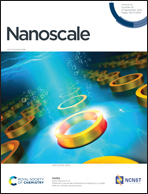Influence of cationic groups on the antibacterial behavior of cationic nano-sized hyperbranched polymers to enhance bacteria-infected wound healing†
Abstract
With the continuous emergence of drug-resistant pathogens, new strategies with high antibacterial efficacy are urgently needed. Herein, five cationic nano-sized hyperbranched polymers (CNHBPs) with cationic functional groups have been constructed, and their antibacterial mechanism has been studied in detail. CNHBPs bearing secondary ammonium salt groups and long alkyl chains (S12-CNHBP) exhibited weak antibacterial and antibiofilm ability, while CNHBPs bearing quaternary ammonium salt groups and long alkyl chains (Q12-CNHBP) showed the highest antimicrobial and strongest antibiofilm activities. ζ potential and isothermal titration microcalorimetry (ITC) results suggest that the negatively charged surfaces of bacterial cells provided Q12-CNHBP with a higher intrinsic electrostatic driving force for bacterial killing than that with S12-CNHBP. Fluorescent tracing and morphological observations indicate that the bacterial genome might be another antibacterial target for S12-CNHBP in addition to the cell wall and membrane, which are mainly antibacterial targets for Q12-CNHBP, making it less likely to induce bacterial resistance. Surprisingly, Q12-CNHBP exhibited superior in vivo therapeutic efficacy in a mouse wound model of methicillin-resistant Staphylococcus aureus (MRSA) infection with low toxicity during treatment. These advantages and ease of preparation will undoubtedly distinguish Q12-CNHBP as a new class of suitable candidates to combat multidrug-resistant pathogen infections. This study opens up a new avenue for exploiting antibacterial biomaterials to treat infections caused by drug-resistant bacteria.



 Please wait while we load your content...
Please wait while we load your content...